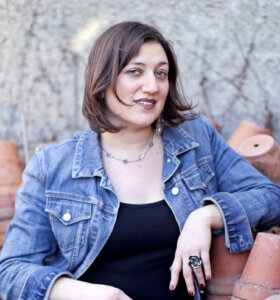Suddenly, Yiddish Theater Is Everywhere!

Graphic by Angelie Zaslavsky
“Fiddler on the Roof” has made headlines of late as public figures have expressed their love for Yiddish theater. Interestingly, what brings on the love is the Yiddish language itself.
Alan Dershowitz is not primarily known as a theater critic, but he was so moved by a recent Yiddish performance of “Fiddler on the Roof” at the National Yiddish Theater Folksbiene that he wrote an op-ed urging readers to see it, whether they knew Yiddish or not. “Hearing Yiddish spoken and sung in Anatevka brought the shtetl not only into my psyche, but into my nashama (look it up if you don’t understand),” Dershowitz effused in the Daily News. “Yiddish is a musical language whose emotion needs no translation.”
Apparently, Dershowitz can understand Yiddish when it counts. “I understand some Yiddish because when my grandmother yelled at me it was in Yiddish,” he wrote.
And though it might be noted to the powers that be at the Daily News that the usual transliteration of the word for “soul” is neshama, not nashama, and the author’s name is Sholem Aleichem as opposed to Shalom Aleichem, the warmth of Dershowitz’s endorsement came through.
What thrilled Dershowitz is actually a translation of English into Yiddish. In 1965, Shraga Friedman translated Sheldon Harnick’s English lyrics into Yiddish; Harnick and Bock, of course, based their “Fiddler” on Sholem Aleichem’s writing in Yiddish. Masterworks Broadway, the blog of Sony Music Entertainment, called the translator’s task here “unenviable.”
Friedman made some notable transformations; “If I Were a Rich Man” became “Ven Ikh Bin a Rotshild,” or “If I Were a Rothschild.”
The Yiddish run of “Fiddler” at the Museum of Jewish Heritage theater, which has 350 seats, has been extended four times, and is performed with projected English and Russian translations. In February, “Fiddler” is moving to 42nd Street, to a larger theater at Stage 42 — with 499 seats. Not bad for a first run of a Yiddish translation in America.
While this might seem like a New York story, the success of Yiddish theater is actually an international phenomenon.

His Latest Iteration: A still from the forthcoming film of “Gimpel the Fool.” Image by Gimpel the Fool
“Gimpel the Fool,” a play based on Isaac Bashevis Singer’s classic short story, has made its way around the world, including to various towns in Singer’s native Poland, according to Howard Rypp of Nephesh Theater, in Tel Aviv, who first wrote the play in English and then worked to bring it into Yiddish.
“Like all the performances abroad, the production is presented with simultaneous translation,” Rypp told me. People everywhere can relate to Gimpel, he said, because “ in every religion there is an archetype that is a holy fool.
“Singer also wrote that to be universal you must be specific. So even though his writings are so specifically Jewish they are universal for everyone.”
Yiddish theater always seems to find a way to endure, and now it is even experiencing a revival in Israel, where Yiddish was long looked down on as a stepchild, less desirable than Hebrew — the symbol of strength, independence and survival at all costs.
But maybe Yiddish theater is the true symbol of strength. I learned early on that, if necessary, Yiddish theater will come knocking on your door, insisting that you personally play a role in its survival.
When I was a child, in Monsey, New York, little girls went door to door selling tickets for Yiddish theater productions — and sometimes, Yiddish musicals, or musicals in Yiddish translation. The productions were fundraisers for girls’ yeshivas. I saw “The Mikado” in Yiddish with my mother; all the audience members were women, and of course, the entire cast was female, too.
The idea was to give female actresses, singers and dancers a chance — because religious women do not sing in public. Although I didn’t understand every word of every song, I understood something more important: the feeling of theater in Yiddish.
A few months ago, I saw “Gimpel the Fool” at Yung Yiddish, the Yiddish book annex and performance space housed in Tel Aviv’s Central Bus Station. I recognized some of the audience members: Yiddish graduate students, all of whom seemed to smoke; a Yiddish translator who also teaches yoga — in Yiddish, of course; a young man who had left his Hasidic life to become a modern dancer, and some older Yiddish speakers who are regulars at Yiddish cultural events in Tel Aviv.
Though I feared that I would not understand “Gimpel the Fool” in Yiddish, I did. (Dershowitz may have a point.) “The Mikado” in translation had prepared me for “Gimpel.” And of course, a Monsey childhood had prepared me for the music.
But was the play itself written by Singer?
Not exactly.
The story of “Gimpel the Fool” the play in Yiddish is the fascinating tale of exile writ backward. Singer originally wrote the story in Yiddish; Saul Bellow famously translated it into English, putting Singer on the map. Then, a few decades later, Rypp, founder of the Nephesh Theatre company, which began in Edmonton, in Alberta, Canada, and then moved to Tel Aviv with Rypp, took Bellow’s short story and made it into a play in English.
The production premiered at the Edinburgh Festival Fringe. Since then it has reached Austria, Armenia, the Czech Republic, Egypt, England, Poland, Russia, the United States and Canada. In 2013 it won the grand prize at the Macedonia International Monodrama Festival.
Then the International Yiddish Theatre Festival, in Romania, asked Rypp for a Yiddish production. Since Rypp doesn’t speak Yiddish, he looked for a partner.
“I searched and found Dori Engel, who is well versed in the language and super-talented,” he said.
Engel was the actor I saw, playing Gimpel magnificently. He is a Yiddishist who also studied Shakespearean acting in London; Engel and Rypp worked together to bring Gimpel to the stage in Yiddish. I can report that the audience was spellbound.
“I.B. Singer once said that you lose 50% in translation, so he writes 150%,” Rypp said. I would add that Engel gave 150%, too.
“Gimpel” has now toured the world in both the original Yiddish and the translation, including Singer’s native Poland, where Rypp recently brought the English production to 12 towns that Singer wrote about in his work. “Gimpel” was part of a festival that included a giant circus adaptation of “The Magician of Lublin.”
And, of course, since this is all inspired by Singer, there were some unexpected encounters.
In Warsaw, Rypp met Meirav Chen — Singer’s granddaughter, who had come to Poland from Israel because of a park that was named after her grandfather. The two have kept in touch, and Chen is assisting with securing the rights for the next incarnation of “Gimpel” — film.
Rypp documented his experience by presenting “Gimpel” in towns mentioned by Singer, and he is editing a film about his journey to Poland and his interactions with today’s Polish audiences. I was curious about the wildest thing that had happened to “Gimpel the Fool” on tour, besides meeting Singer’s granddaughter.
“The most surprising moment was when I presented in Egypt,” Rypp recalled. “There, after the show, a woman remained and revealed to me that she also was Gimpel the fool.”
Hmm, I thought, feeling transported to some of Singer’s stories.
“I, of course, asked her what she meant. She told me that she was married and for years she was also ‘fooled,’ and had no idea that her husband was married to other women. In Egypt, there is no law against a man having more than one wife, but now the law states that he must inform his wife of such.”
Legally, at least, knowing is better than not knowing.
But on one aspect of knowledge, I agree with Dershowitz, and with the audiences worldwide who are making both “Fiddler” and “Gimpel” into hits: You don’t need to understand every word of a Yiddish play to understand it completely.
Aviya Kushner is the Forward’s language columnist and the author of “The Grammar of God” (Spiegel & Grau, 2015). Follow her on Twitter, @AviyaKushner

















